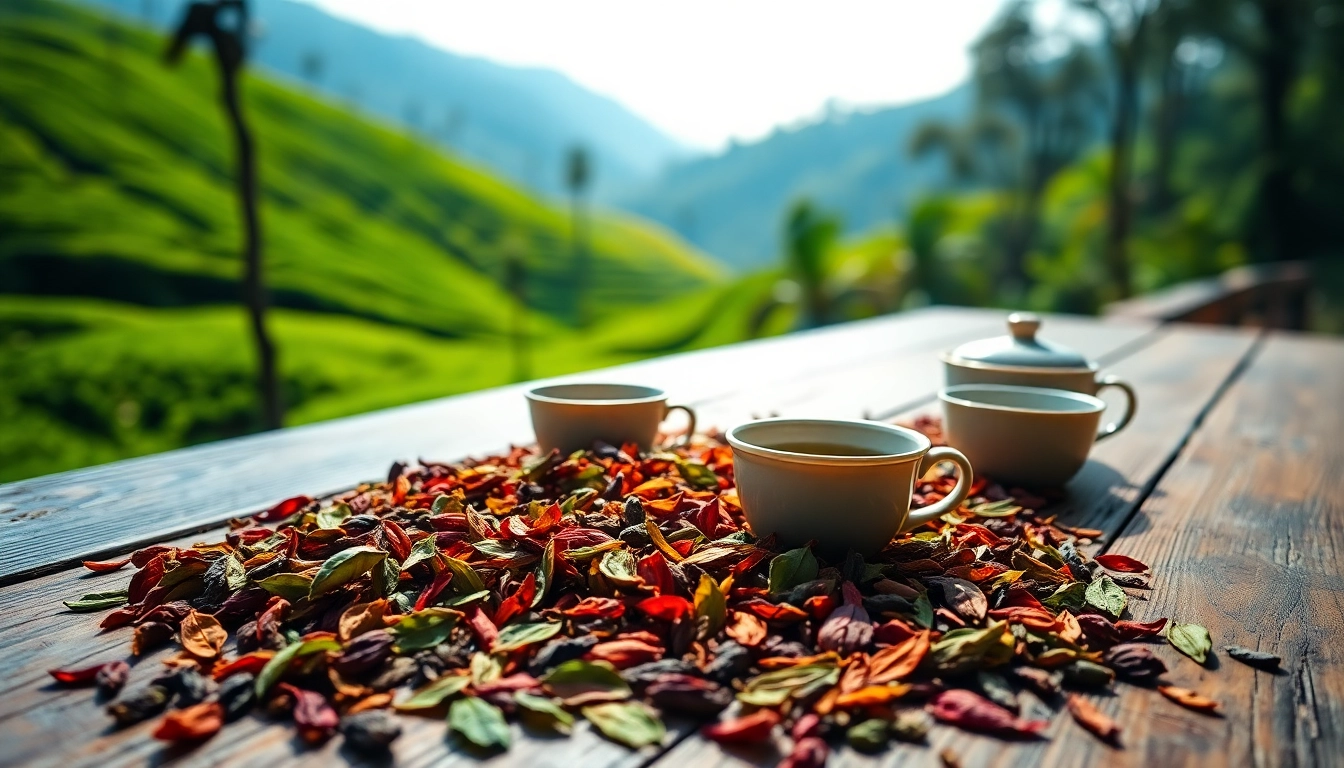1. Introduction to Nepali Tea
Nepali tea, often overlooked in the global tea market, offers a wealth of flavors and aromas that speak to its unique heritage and cultivation practices. Grown primarily in the high-altitude regions of Nepal, especially in the acclaimed tea-producing area of Ilam, Nepali tea has begun to carve out its identity, distinct yet intriguingly similar to its famous neighbor, Darjeeling. Whether you are a tea aficionado or a casual drinker, exploring Nepali tea can provide insight into a rich tradition of artisanal tea-making that embraces both history and innovation.
1.1 The History of Tea Cultivation in Nepal
The history of tea cultivation in Nepal dates back to the early 19th century, following its introduction by the British during their colonial period in India. Cultivation began on a small scale, but it gradually expanded as farmers recognized the plant’s commercial potential. The elevating geography of Nepal, characterized by its stunning mountains and valleys, provides ideal conditions for growing high-quality tea leaves.
Today, the country boasts numerous tea gardens that contribute to both domestic consumption and international exports. Tea from Nepal has gained recognition, particularly for its organic practices, handpicking techniques, and small-scale farming that prioritize quality over quantity. Over the last few decades, as the world has become more health-conscious and environmentally aware, Nepali tea has surged in popularity, with both traditional and innovative blends coming to the forefront.
1.2 Unique Characteristics of Nepali Tea
Nepali tea is celebrated for its unique characteristics. The country’s varying altitudes, rich soils, and diverse climates influence the tea’s flavor profiles. While it shares similarities with Darjeeling tea, Nepali tea often offers a broader spectrum of tastes, including floral notes, green freshness, and a subtle muscatel flavor.
Moreover, the traditional methods of processing and the commitment to organic practices allow for a distinctive aromatic experience, setting Nepali tea apart in the crowded global market. The beautiful, hand-rolled tea leaves frequently exhibit striking colors and varied leaf shapes, adding to their allure.
1.3 Comparing Nepali Tea with Other Global Varieties
When comparing Nepali tea to its more famous counterparts such as Darjeeling, Assam, or even Chinese varieties, several factors come into play. Nepali teas can be lighter in body and possess a delicate flavor that some may find refreshing when compared to the robust characteristics of Assam tea. Additionally, Nepali tea offers various inflections in taste due to the local terroir, climate, and tea processing techniques.
Whereas Ceylon tea is known for its bright, brisk tastes and extensive flavor ranges, Nepali tea presents a smoother profile, rich in complexity. These subtle differences can appeal to diverse palates, inviting tea lovers to explore and enjoy the enchanting world of Nepali tea.
2. Different Types of Nepali Tea
Nepal is home to a wide variety of teas, each with its unique preparation methods, flavors, and health benefits. This section delves deeper into the categories of Nepali tea, underlining the differences and merits of each.
2.1 Black and Green Teas from Nepal
Nepali black teas are often noted for their rich flavors, resembling the depth of their Indian counterparts while telling their own story through unique profiles. Renowned varieties include the Ilam High-Altitude Black Tea, known for its smooth characteristics and sweet notes, often leaving a lingering taste that tea enthusiasts cherish.
On the other hand, Nepali green teas are distinguished by their vivid color and fresh aroma, characterized by the delicate plucking of young tea leaves. Often processed through minimal oxidation, they maintain a grassy, vegetal flavor that’s refreshing and invigorating. Both black and green varieties carry complex notes, making them perfect for different times of the day—black tea for a robust morning drink and green tea for a calming afternoon sip.
2.2 Special Preparations and Flavors
The preparation of Nepali tea can significantly affect its flavor profile. While many enjoy their tea simply brewed with water, there are traditional recipes that integrate spices and additional flavors, enhancing the drinking experience. One popular method is making ‘Nepali Chiya’, a spiced milk tea that includes ginger, cardamom, and sugar. This comforting brew is historically enjoyed throughout Nepal, particularly during family gatherings and celebrations.
Additionally, innovative blends have emerged among local farmers, such as fruit-infused teas and herbal concoctions that resonate with wellness trends. This adaptation maintains the traditional essence while appealing to modern tastes, allowing more consumers to experience the rich culture behind Nepali tea.
2.3 Organic Farming and Sustainable Practices
With the rise in global demand for organic products, Nepali tea farmers have remained at the forefront of sustainable agriculture. Most tea plantations adhere to organic farming practices, abstaining from synthetic pesticides and fertilizers. Instead, they utilize traditional methods, including composting and integrated pest management, to promote health and biodiversity in their ecosystems.
This commitment to organic cultivation not only ensures that the teas produced are of the highest quality, but it also protects the environment. For consumers, choosing organic Nepali tea means supporting sustainable practices and contributing to the health of the planet.
3. Brewing the Perfect Cup of Nepali Tea
Brewing Nepali tea is an art that requires attention and care. This section provides essential tips for brewing the perfect cup that brings out the best qualities of the tea.
3.1 Best Practices for Brewing
To truly experience the intricate flavors of Nepali tea, it’s vital to follow best practices during brewing. Typically, black tea requires boiling water (around 200°F), while green tea is best brewed at lower temperatures (around 175°F). Using fresh, filtered water enhances the taste, as hard water can diminish the quality of the brew.
The steeping time also plays a key role; black tea should be steeped for about 3-5 minutes, whereas green tea needs only 2-3 minutes to prevent bitterness. Experimenting with steeping times and temperatures will allow each individual to discover their preferred flavor.
3.2 Essential Equipment for Tea Brewing
Basic equipment for brewing tea includes a kettle, teapot, and infuser. While a standard kettle works fine, investing in a temperature-controlled kettle allows for accurate heating. A teapot or a well-designed infuser ensures proper steeping, allowing leaves to expand and release their flavors effectively.
A traditional Nepali chai pot called ‘patila’ can be an authentic touch for those preparing Nepali Chiya, inviting a richer cultural experience into your brewing routine.
3.3 Enhancing Flavor with Additives
For those who enjoy experimentations, adding spices, milk, or natural sweeteners can create an array of flavors in your tea. Common spices include cardamom, ginger, and even cinnamon. Milk is often added to black tea to create creamy beverages, while honey or agave syrup can sweeten the brew without overpowering its natural essence.
By integrating these elements, one can not only personalize the flavor but also explore the cultural practices associated with drinking tea in Nepal.
4. Health Benefits of Nepali Tea
The health benefits of Nepali tea have been recognized worldwide. This section illustrates some of the key advantages associated with regular consumption of this beverage.
4.1 Antioxidants and Nutritional Value
Nepali teas are rich in antioxidants, particularly polyphenols, which combat oxidative stress in the body. These compounds can enhance heart health, reduce cholesterol levels, and even help in preventing chronic diseases. Regular consumption of both black and green teas has been linked to improved well-being over time.
Moreover, the nutritional value of Nepali tea includes essential vitamins and minerals, providing numerous health benefits while contributing to overall hydration.
4.2 Immunity Boosting Properties
A notable feature of Nepali tea is its immunity-boosting properties. The inherent antioxidants, coupled with the warmth of traditional spices found in Chiya, can bolster the immune system. Elements like ginger and cardamom are known for their anti-inflammatory benefits, contributing positively to respiratory health and overall immune resilience.
4.3 Relaxation and Mental Clarity
Many tea drinkers find comfort in a warm cup of tea, which can provide relaxation and stress relief. The calming effects of certain Nepali teas, especially green varieties, result in improved mental clarity and focus. Regular consumption can enhance mood and promote a sense of well-being.
5. Where to Purchase Authentic Nepali Tea
With the growing popularity of Nepali tea, numerous avenues exist for sourcing authentic products. This section provides guidance on where to find high-quality teas, ensuring consumers can easily enjoy this rich heritage.
5.1 Online Retailers and Organic Options
Several online retailers specialize in selling organic Nepali tea directly from the farms. Platforms like Nepali Tea Traders and dedicated organic tea websites offer consumers a secure way to purchase authentic teas. Opting for these sites guarantees products that are ethically sourced and often come with transparent labeling.
Moreover, these retailers frequently provide options for sample packs, allowing new consumers to try various blends before committing to larger quantities.
5.2 Local Shops and Specialty Markets
For those preferring to shop in person, many ethnic grocery stores and specialty tea shops are beginning to stock Nepali teas. Exploring local markets can lead to discovering unique blends and may provide insights into the different regions of Nepal from which these teas originate. Engaging with shop owners who have traveled to Nepal can enrich your knowledge about the teas.
5.3 Upcoming Nepali Tea Expos and Tastings
Participating in tea expos, festivals, and tastings can provide an excellent opportunity to discover Nepali tea. These events often showcase local producers and allow consumers to sample various teas while learning from experts about their origins and brewing methods. Keeping an eye on local tea events or global tea festivals can lead to unique cultural experiences and authentic tea encounters.














Leave a Reply